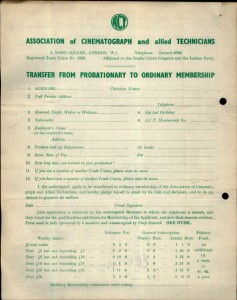Women and Media Histories
Objectives
The four principle objectives of the project are:
- To identify how many women worked in the British film and television industries between 1933 and 1989, and the range of roles in which they were employed. Here the team will draw on union membership records and BBC staff lists to produce a quantitative survey of women’s labour.
- To explore women’s experiences in film and television production. Oral history interviewing will be the principle means through which the team will engage in dialogue with women practitioners, exploring the material texture of their working lives and the production cultures in which they worked and helped to shape.
- To produce case studies of key industry grades and production areas, and look at women’s contributions to that grade. Here the team are particularly interested to explore roles, which have received relatively little scholarly interest to date – wardrobe and make-up for example – and women’s work in regional ITV companies and BBC production centres.
- To create a sustainable resource which draws together statistical data and qualitative material which will be of interest to a wide range of people including researchers of media, labour and social history, archivists, practitioners working in the creative industries and their representative bodies.

Page from an application form to join the Association of Cinematograph and allied Technicians (ACT) from the 1950s.
Preliminary Findings
In the first six months of the project the team have been working to identify potential candidates for interview. Notices about the project were placed in industry/trade newspapers, journals and websites. These generated responses from a diverse range of women who had worked in film and television production: production assistants, editors, researchers, PAs, wardrobe assistants, make-up artists, producers and others. The team have heard from women who worked across advertising, commercials and television, who switched from costume design to casting, and who worked in regional newsrooms. Women have told us about the technical equipment they worked with, the training they received, the friends they made, the money they earned, how they spent it and who made the tea. Although the project is still in its early stages preliminary research has opened up not only gendered but also regional and working-class perspectives on production, which challenge the existing histories written predominantly from white, southern, and middle-class perspectives.
The project will interview about twenty-five women. These interviews take a ‘life story’ approach; interviewing over several sittings and exploring themes of upbringing, education and home, as well as focussing in depth on work and the everyday work experience. This approach will produce a richly-textured and multi-faceted personal narrative with considerable research potential for current and future projects. The project will generate approximately 150 hours of recorded material, which will be preserved on the resource created by the BUFVC.
Delivering content online
One of the project’s major outputs is a digital resource and here the project team are working closely with the BUFVC who are leading on developing the technical specification. At the core of this resource are the membership application records made to the film and television trade union BECTU (known as ‘ACT’ and ‘ACTT’ in earlier incarnations). These extant records are complete for the period 1933 to 1989 and provide a unique picture of employment in the British film and television industries. The ‘closed shop’ nature of the industries meant that all employees applied for a union ticket, thus the ‘great and the good’ – David Lean, Joseph Losey, Muriel Box – applied for membership alongside their less well-known co-workers. Furthermore as the union’s structure covered not only film production (shorts, documentary, features, newsreels) and independent television but also the laboratory branch, the records provide unique access to a sector of the industry which to date has received relatively little scholarly interest.
The resource created by BUFVC will host both scanned copies of all 67,000 membership applications and a fully-searchable database of specified core fields including gender, grade, employer, rate of pay and date of application. Including men as well as women not only allows comparisons by gender to be made, but preserves the integrity of the collection and ensures its value for future research projects. In addition to the membership applications the resource will also host the twenty-five oral history interviews. These will be fully searchable on-line with synchronous transcriptions i.e. rolling text will be visible as the words are spoken. The oral history material will be accompanied by a comprehensive index, narrative summaries and navigational brochure. These two collections will be integrated within a website comprising historical context and research case studies written by the research team.

 Learning on Screen
Learning on Screen